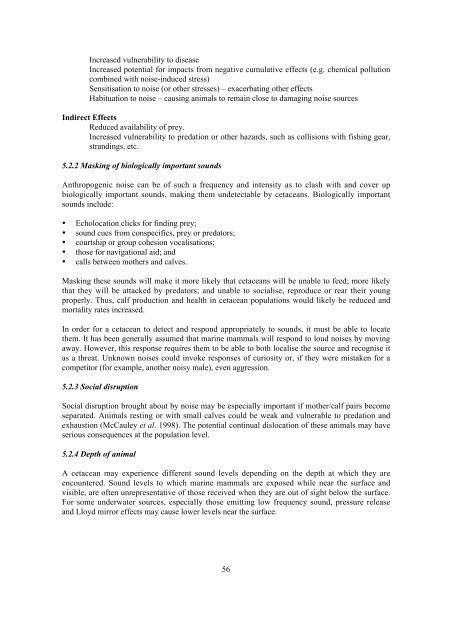Oceans of noise - Whale and Dolphin Conservation Society
Oceans of noise - Whale and Dolphin Conservation Society
Oceans of noise - Whale and Dolphin Conservation Society
- No tags were found...
Create successful ePaper yourself
Turn your PDF publications into a flip-book with our unique Google optimized e-Paper software.
Increased vulnerability to diseaseIncreased potential for impacts from negative cumulative effects (e.g. chemical pollutioncombined with <strong>noise</strong>-induced stress)Sensitisation to <strong>noise</strong> (or other stresses) – exacerbating other effectsHabituation to <strong>noise</strong> – causing animals to remain close to damaging <strong>noise</strong> sourcesIndirect EffectsReduced availability <strong>of</strong> prey.Increased vulnerability to predation or other hazards, such as collisions with fishing gear,str<strong>and</strong>ings, etc.5.2.2 Masking <strong>of</strong> biologically important soundsAnthropogenic <strong>noise</strong> can be <strong>of</strong> such a frequency <strong>and</strong> intensity as to clash with <strong>and</strong> cover upbiologically important sounds, making them undetectable by cetaceans. Biologically importantsounds include:• Echolocation clicks for finding prey;• sound cues from conspecifics, prey or predators;• courtship or group cohesion vocalisations;• those for navigational aid; <strong>and</strong>• calls between mothers <strong>and</strong> calves.Masking these sounds will make it more likely that cetaceans will be unable to feed; more likelythat they will be attacked by predators; <strong>and</strong> unable to socialise, reproduce or rear their youngproperly. Thus, calf production <strong>and</strong> health in cetacean populations would likely be reduced <strong>and</strong>mortality rates increased.In order for a cetacean to detect <strong>and</strong> respond appropriately to sounds, it must be able to locatethem. It has been generally assumed that marine mammals will respond to loud <strong>noise</strong>s by movingaway. However, this response requires them to be able to both localise the source <strong>and</strong> recognise itas a threat. Unknown <strong>noise</strong>s could invoke responses <strong>of</strong> curiosity or, if they were mistaken for acompetitor (for example, another noisy male), even aggression.5.2.3 Social disruptionSocial disruption brought about by <strong>noise</strong> may be especially important if mother/calf pairs becomeseparated. Animals resting or with small calves could be weak <strong>and</strong> vulnerable to predation <strong>and</strong>exhaustion (McCauley et al. 1998). The potential continual dislocation <strong>of</strong> these animals may haveserious consequences at the population level.5.2.4 Depth <strong>of</strong> animalA cetacean may experience different sound levels depending on the depth at which they areencountered. Sound levels to which marine mammals are exposed while near the surface <strong>and</strong>visible, are <strong>of</strong>ten unrepresentative <strong>of</strong> those received when they are out <strong>of</strong> sight below the surface.For some underwater sources, especially those emitting low frequency sound, pressure release<strong>and</strong> Lloyd mirror effects may cause lower levels near the surface.56




